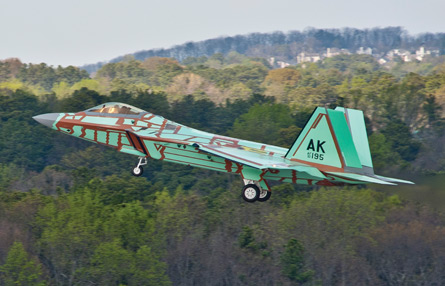The US Air Force's Scientific Advisory Board (SAB) investigating the Lockheed Martin F-22 Raptor's life support system found that the service has allowed its aerospace physiology expertise to deteriorate. As part of a solution to the Raptor's woes, the USAF will have to rebuild those capabilities.
"We reduced the emphasis and the numbers of people associated with aviation physiology research and science," says retired Gen Greg Martin, who led the SAB study.
During the 1990s Cold War drawdown, the USAF shrank from around 600,000 personnel to a current level of around 330,000, Martin says. Among the casualties of the drawdown were aviation physiologists even as the service worked to develop the Raptor, which operates at far high altitudes than existing fighters.
"The Centre of Excellence for Aviation Physiology, Human Systems Integration and those sorts of things need to be re-established because we are operating an aircraft in an environment with systems that perform differently than before, and they may have some effect on the humans' response and in the human reaction," Martin says. "We're not aware of some of those yet. And we did not have the research to do it."
 |
|---|
Kevin Divers, CEO of Warrior Edge, an aircrew flight equipment distributor and physiology/human factors consulting firm, says that the current training for USAF aerospace physiology is inadequate. The career field, though manned by good people, needs a better connection to the science they study and to its application in the operational flying arena. "They need to have a better bond with the aircrew they are to work with," the former F-22 flight test engineer says. "This could be done by putting the trainees through the first phase of pilot training before they complete their formal air force training in aerospace physiology"
It would help to have about 10 flights in a Hawker-Beechcraft T-6 trainer, Divers says. That would be similar to what the US Navy does for its physiologists, but even cockpit simulator time at their operational bases would be useful. That is especially true for bases with single-seat aircraft only.
At one time, the USAF used to have its physiologists fly in a general aviation aircraft during their initial training to familiarize themselves with the cockpit, but that programme was discontinued due to funding. But even that programme was not "particularly dynamic nor a way to instil an air force aircrew mindset" Divers says.
But at a more basic level, physiologists need to be trained on the actual hardware pilots use, "even if it is through a simulator with actual aircrew training them," he adds.
"If they could be taught more on the science of the equipment," he says, it would help. Currently, physiologists are not instructed to the same standards as the aircrew flight equipment personnel on the actual apparatus pilots use in the air, instead they are taught on PowerPoint slides detailing the very basics of the hardware. "They wear the equipment during their centrifuge training, but not to a standard that would qualify them as an expert or instructor on the equipment," Divers says.
Nor are there any practical recurring training or qualification checks on particular pieces of equipment like a G-suit. "I really think if they put an aircrew style mentality to our training, it would help us, both in our ability to help our aircrew and develop the street credibility that I think we currently lack" he says. "Individual physiologists stand out as very credible sources, but the career field progression does not require this or challenge us to become subject matter experts."
It would also be beneficial if base physiologists had access to a hotline of selected experienced flight surgeons, pilot physicians, or research physiologists, he says.
Another possible measure might be to have a wing pilot trained as a physiologist as a secondary duty-similar to how units have a standards and evaluation officer or safety officer. Such an officer would be better able to interface with pilots and provide the physiology communities a better understanding what an aircraft does to aircrew physiologically.
"There used to be rated-physiologists, that went away," Divers says. "I think if they brought back the rated-physiologists [that would help]. Maybe they might not be able to handle per-squadron, but they may be able to handle per wing."
Source: Flight International























